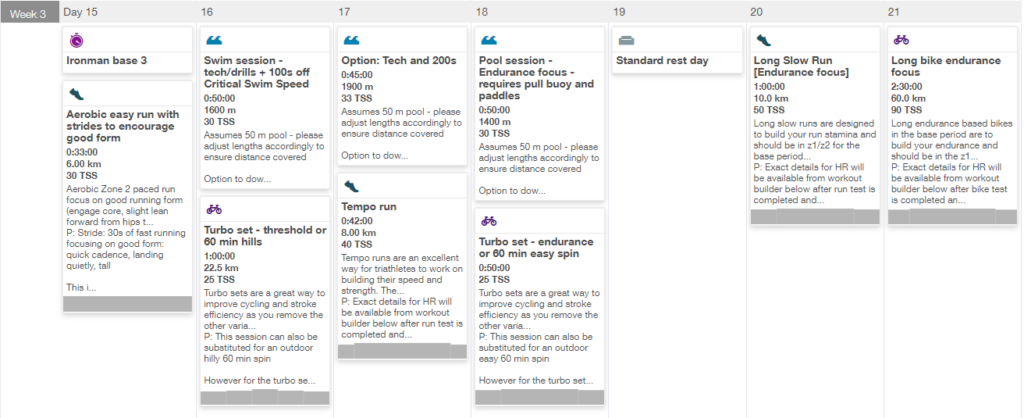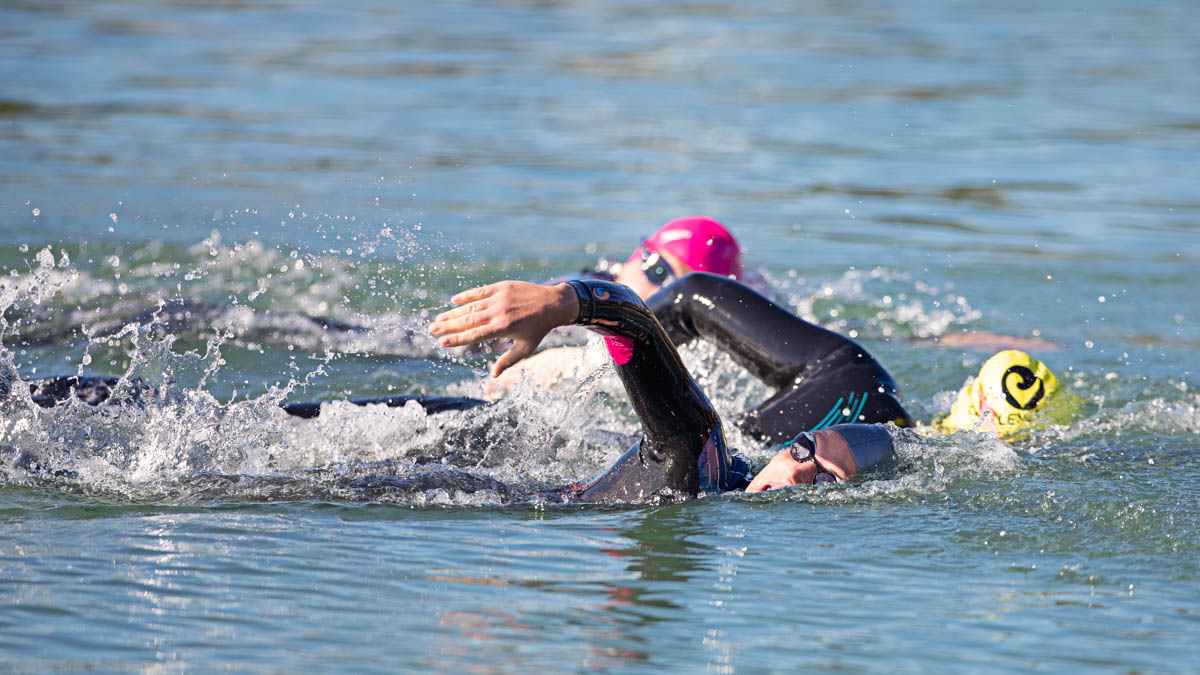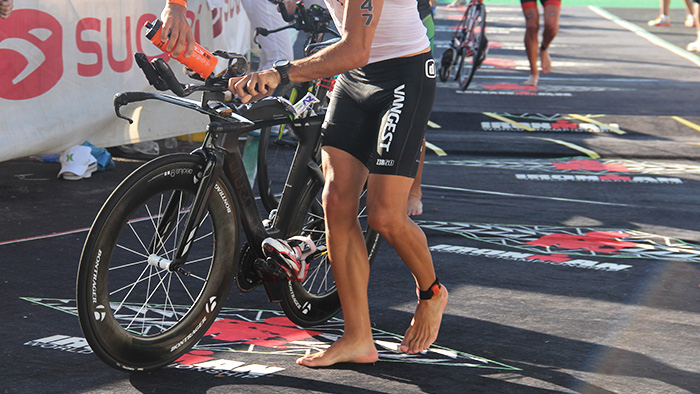Thinking about having a go at your first Ironman? Good for you!
You’ve probably seen social posts of competitors showing off their medals (and in some cases, tattoos), and it’s likely inspired you to get in on the action yourself. But doubt inevitably creeps in as you go to sign up for your first IRONMAN race. Am I ready? Will I be able to do it? What sort of training do I need to cover 3.8 km of swim, 180 km of bike, and then a full marathon?
Fear not — here is all the information you need to turn your impulse purchase into one of the best decisions you’ve ever made.
How Much Triathlon Experience Should I Have Before My First IRONMAN?
It is technically possible to go from “zero to hero” and do an IRONMAN without any prior triathlon experience. There certainly are athletes out there who have done just that. But why would you want to?
Before taking on a full distance Ironman, consider getting a couple of years of triathlon experience first. Racking up a couple of standard distance races (aka, Olympic distance) gives you the training base and the race experience to achieve your best on the big one. Most importantly, this experience will help you understand that triathlon is much more than a sport; it’s a lifestyle choice filled with fun, energetic, can-do individuals. Taking your time and enjoying the journey means you are more likely to become a true member of the tri community and less likely to join the ‘one and done club’. If you don’t have that experience yet, check out plans for sprints and standard distance races and come back to this article next year!
If you have that experience in the bag, read on to learn about the training it will take to achieve your IRONMAN dream.
IRONMAN Training Time Commitments
This part is twofold: how much time are you going to need to train for your IRONMAN, and how will you find that time in your existing schedule?
Training Load
Training load varies quite a bit. It can start as low as six hours a week for beginners and build up to 12-14 hours per week in the last few weeks of your plan. In general, you can expect to do 6-9 training sessions a week — including 2-3 swims, 3 bikes, and 3 runs — depending on your availability.
These sessions will include a long run and a long bike, which are the secret sauce to making it to Ironman level. They are best completed on the weekends for the average person working office hours.
Time Management
All of that might sound like a lot, particularly when you’re hitting peak volume at 14 hours per week in the final few weeks of the plan; so it’s essential to think about how you will fit your training in with your existing schedule and commitments. The good news is that this is doable, but it requires good planning (including race selection) and time management.
A good place to start is to:
- Map out your average week with your family and find your potential training spots.
- Map out the days and times when you cannot train (e.g., hectic work periods or family commitments).
- Use this information to draw out a realistic ‘skeleton’ week and get your support crew (friends, family, etc.) involved as it will give you a real idea of how you can make it work.
- Decide what sacrifices you are willing to make and how you can maintain your family life. You might be looking at early starts, commute cycles, or lunchtime runs to fit everything in — just choose what works best for you. Remember, there will need to be some sacrifices, but you can catch up on Netflix bingeing in the off-season!
Pro Tip: Talk to your extended support team about why doing an IRONMAN is important to you and how it might impact them. Making them a part of the process rather than a victim of it will be critical to your success, so get them on board from the get-go. Pick a cool race location and turn the whole experience into a race-cation so they can cheer you on and enjoy a holiday celebrating your achievement (credit to Jen Rulon for this idea, check out more here).
Once you have looked at what is involved and you and your support team think you can make it work, then read on!
IRONMAN Training Phases
Phase 1: Base
| Discipline | Number of Sessions Per Week | Avg Time | Focus |
| Swim | 2-3 | 2 hrs | -Endurance -Technique |
| Bike | 3 | 4 – 6 hrs | -Endurance -Strength |
| Run | 2-3 | 2 – 3 hrs | -Endurance |
You’ll start your IRONMAN training off by building a base level of fitness that sets you up for the later stages of training. This first phase of training (aka, the base phase) is simply about increasing fitness. The majority of your sessions at this stage will be at lower intensities (based on your specific heart rate zones that will be tested/inputted into Training Peaks). You will steadily increase in volume as you progress through the plan. Below is an example of a week in the base phase of an IRONMAN training plan.

Phase 2: Build
| Discipline | Number of Sessions Per Week | Avg Time | Focus |
| Swim | 2-3 | 2-3 hrs | – Endurance -Speed |
| Bike | 3 | 5 – 7 hrs | -Endurance -Race Pace Efforts |
| Run | 2-3 | 3 – 4 hrs | -Speed & Power -Race Pace Efforts -Bricks |
Once your base is in place, you’ll move onto the build phase of IRONMAN training. This stage focuses on getting you ready to race by moving to higher intensities with some speed-focused endurance. Remember that your training plan is tailored to your heart rate zones, which will be reassessed at the start of the build phase so that they reflect the gains made in the base phase.
As your plan progresses, the duration and distance of higher-intensity sessions will increase, with greater emphasis on race pace efforts. This is the perfect time to enter some practice races (i.e., B or C races) to test yourself and have some fun!
Below is an example of a week in the build phase of an IRONMAN training plan.
Phase 3: Peak
As your fitness and confidence build, you soon will be ticking off the longer sessions with ease. You’ll even come to consider a 21 km run for a 120 km bike a “light” weekend! It is around this time you will be nearing peak load.
As a coach, this is where my athletes tick off some great milestone sessions like a full 180 km ride — testing out race day equipment and nutrition as part of the process — with a brick ride of around 5 km off it. In terms of run volume, I limit the longest stand-alone runs for beginners at 28-30 km as you will already have fitness and strength gains from the long bike and want to minimize the risk of injury that too much running volume can bring.
The good news is that after this peak phase, all the hard work is done and the reward of race day is tanalising close. Below you’ll find an example of a peak week in an IRONMAN training plan.
Phase 4: Taper
Tapering is where you really ease off the training volume to allow your body to consolidate the hours of training you have banked. You will be like a coiled spring ready to fire, but will have to deal with some taper oddities like an irrational fear you are losing fitness by the hour — spoiler alert: you are not! — and the fact you are available a lot on the weekend. Trust in the plan and the process by embracing this period of rest, working on your race logistics and strategy, and starting to visualise the big event! You have got this! And here’s what you’ve got to look forward to during your taper:
Finding the Right Support: Training Plans and Coaches
If you are still with me and think this all sounds doable, the final thing to consider is what kind of coaching support you will need to achieve your IRONMAN goals. There are many options here, and there’s no need to go crazy to get great results.
A cost-effective option is to buy one of the many excellent stand-alone training plans from the TrainingPeaks plan store. These readymade plans are best for triathletes on a budget and those who are good at keeping themselves accountable. A good plan will walk you through everything from testing your heart rate zones to progressing in each week’s training. The plan will communicate directly with your sports watch and TrainingPeaks app so that there’s no fiddling with settings for each session. TrainingPeaks is very user-friendly: you can move sessions as needed and visually track your progress, which is great to keep you motivated!
Another option is to find and hire a coach. This may be a more expensive option, but it can be worth it for the extra accountability and support. To make finding a coach much easier than sifting through searches, check out TrainingPeaks Coach Match. This service will match you with an experienced coach who can work with you to deliver a specialized plan, monitor your progress, and adapt your training. This option is suitable for those who want a more personalized approach to training than a readymade plan can provide.
A third option — and really one that should be used in tandem with either a plan or a coach — is to find your IRONMAN community. Identify a group or club you can train with towards your goal, like a local triathlon club or a virtual support community. A good hybrid option is to choose a TrainingPeaks plan with a support community like my own PB hit squad from SMart Endurance Solutions. This option is best for those who want the best of both worlds: a cost-effective solution with community support to help them reach their goals.
A Quick Recap
So, after reading this article, are you ready to take the first step towards your own social media boast post? If you can tick off the following boxes, then you’re ready to start training for your first IRONMAN!
- You have a couple of years of triathlon experience, including some racing.
- You have between 6 – 12 hours a week to train.
- You have identified where you can fit in all the different training sessions in your weekly schedule.
- You have talked it through with your support squad, and everyone is excited!
- You have identified the coaching support that will work best for you.
Now it’s time to find a race and purchase your entry!
The reality is, this will mean crazy early starts, training when you are tired after work, skipping Sunday brunch for long grueling bike rides, and swapping happy hour for foam rolling. It’s going to be hard, very hard. But plan it properly, and it’s also going to be one of the most amazing transformational journeys of your life.
Beginner IRONMAN 36-Week Training Plan
Beginner IRONMAN 28-Week Training Plan
Beginner IRONMAN 24-Week Training Plan for the Time-Crunched Triathlete
See you at the start line!








